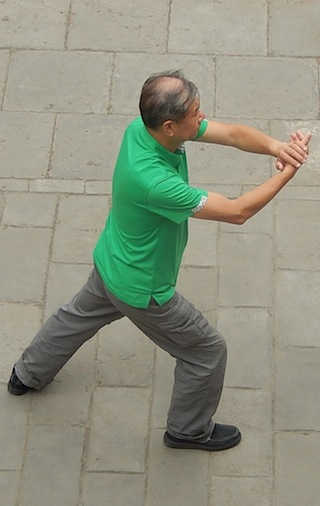“Where are all the fancy moves?” That’s what I wanted to know.
When the internet emerged, I couldn’t wait to peek inside other martial arts schools to see what they were doing.
So many styles! So much mystery!
But each time I clicked on a video of Choy Lee Fut, Shorin Ryu, Praying Mantis, Hung Gar, This-Do, or That-Ryu, I kept seeing the same thing—kickboxing.
Punch, kick. Punch, punch, kick. Frankly, in many cases, it wasn’t even good kickboxing!
Where are the throws? The takedowns? The locks?
Where are the sweeps? The jumps? The rolls? You know—
Where are all the fancy moves?
What a disappointment.
All this talk about hard versus soft, internal versus external, circular versus straight, Eastern versus Western, ancient versus modern, and in the end? It didn’t matter. When it came to fighting, everyone was throwing jab, cross, round kick.

Is that it—jab, cross, round kick?
Is that all the martial arts have to offer? Is that the legacy of thousands of years of combative trial and error? Is that all I should be passing down to the next generation?
Don’t get me wrong—kickboxing is a great sport. I’d rather watch kickboxing than baseball any day! But I refuse to believe that kickboxing is the greatest achievement in human fighting technology. Especially in a real fight.
Which brings us to a question…
With all the different styles out there, with so many different movements to choose from, why do so many people fight the same way?
With so much time spent learning kata, forms, and sophisticated techniques, why do people fall back on the most basic strikes when it’s time to spar or defend themselves?
I’ll tell you why. Strikes are easy.
Yes, basic striking can be sophisticated. Timing, feinting, angling, weight shifting, and creating combinations all require serious practice and experience.
But no matter how you cut it, punching someone in the face in a real fight is a lot easier than taking someone down with a wrist lock or leg scissors.
Like water, it’s human nature to seek the path of least resistance. Therefore, martial arts students stick with the first techniques that bring them success.
People don’t like to feel like failures. People like to feel like winners.
Consider the training progression for striking—
Students learn a strike. Students try the strike. Students land the strike.
FACT: Even beginners are capable of landing a strike. So, they keep doing it.
In contrast, here’s the training progression for fancy moves—
Students learn a fancy move. Students try the fancy move. Students fail to execute the fancy move, get punched in the face, and end up on the floor whimpering.
FACT: Even advanced students are incapable of executing fancy moves in the beginning. So, they stop doing them.
This early failure doesn’t just lead to giving up, it forges a belief:
Fancy moves don’t work. Not for them, not for anyone.
Even in the world of professional MMA fighters, the belief that fancy moves don’t work in a real fight was repeated for years…
You can’t throw someone in a real fight!
You can’t use spinning techniques in a real fight!
Oh, really?
Tell that to Karo Parisyan and Ronda Rousey. Tell that to Jon Jones, Anthony Pettis, and Uriah Hall.

MMA has been a technological arms race since day one. That’s why it’s no surprise that today’s MMA includes an ever-growing list of so-called fancy moves; sophisticated techniques that the “experts” said would never work.
Why is that?
Because fighters are getting smarter. They recognize that surprise is just as important as speed and power. They see the advantage of training techniques that their opponent isn’t accustomed to seeing or training to defend.
The same holds true in a real fight.
Which leads us to the big lesson—
Any technique can work if you make it work.
It ain’t about the technique, it’s about you. Always has been, always will be.
That means if your technique doesn’t work, don’t blame the technique. Get to work figuring out how to make it work.
I asked my Kung Fu San Soo teacher, Sifu Matt Ember, the same question about fancy moves, and here’s what he had to say—
Yes, some moves take longer than others to make work. Some may even take decades! But pushing through failure and doing the work is what separates a weekend warrior from a dedicated martial arts student.
I’m not saying a martial artist must practice every technique from every style to be a master of martial arts. Obviously, life’s too short to master everything.
That’s why it’s called martial ARTS.
The best sports fighters in the world haven’t mastered every technique. Instead, they’ve chosen to master a few tactics and techniques that best fit their mindset and physical capabilities. Techniques they discovered through years of trial and error.
Once they’ve made their choices, they put in the time and effort—the “kung” and “fu”—to make those techniques work most of the time against most opponents.
You should do the same. Figure out your favorite techniques. Research. Experiment.
Figure out how to make them work against big, small, short, and tall.
Practice. Fail. Question.
Don’t get me wrong—if you want to be a kickboxer, be a kickboxer. Just don’t walk around saying that fancy moves don’t work.
Fancy moves work. But only if you do the work first.

Love, love, LOVE this concept!!!!!
Love, love, LOVE hearing it! 🙂
Ossu! [bow]
Hmmm… So that’s what those drills are for – so we don’t lose those fancy moves 🙂
I remember a conversation with my daughter complaining about a kick we’d just learned (reverse roundhouse kick). I told her, “I’m just so darned slow and awkward at it! I’d have to be really, really, really good at it to pull it off.”
So a couple weeks later, I was sparring against her, and it just popped into my head, “Hey, why not try that kick?” So I set her up for it and… surprise! I actually pulled it off – but only because it was the last thing on Earth my daughter expected me to do, especially after I’d whined about it 😉
[bow]
OSU!
Thanks for sharing your story, Jo. Exactly my point! Surprise is a weapon. So, train a couple of fancy moves and keep them in your back pocket for special occasions… like when you need to remind your daughter who’s boss! 🙂
Ossu! [bow]
LOL! You’re welcome. I’ll have to remember that next time she balks at cleaning her room…
[bow]
Nice reminder Sensei! I will remember this when its time to teach Marc a lesson!
Ha! All is fair in love and war! 🙂
Hey Ando,
While I can’t claim to know too much about fighting principles, I liked the explanation of why we opt for the easy combo over the trickier, artsy techniques – it seems like this occers in many areas of life. The thing we can do well quickly gets more attention, and it’s just a self reinforcing cycle.
It’s cool to see how this “arms race” forces the real development and mastery of more advanced techniques in order to get an edge. Do you think such a thing will trickly down to lower levels of competition?
Cheers!
AJ
You’re absolutely right, AJ… satisfaction with early success permeates every field of study. I don’t think advanced techniques will ever trickle down because they will always depend on investing more work. Sure, fancy moves become headline news when people see them used for the first time, but the number of students willing to put in the effort to make those fancy moves their is always small. Most would rather stick to what’s already working.
Thanks for the comment, sir!
This is exactly how it is, frustrates the hell out of me at times too. We’ll spend a whole class learning a few new techniques then told to spar to put them into practice, guess what, another kick boxing session 🙁
The fear of getting the technique wrong and giving your opponent an easy shot to the jaw puts the breaks on wanting to be brave and try something different.
Exactly right. We talk about building courage in the martial arts, but wen it comes to trying new ideas and techniques, we often retreat to the safe and known. If you’re not willing to try something new in practice, you certainly won’t try it for real. So, why even learn it? Thanks for commenting, sir!
Hey
thanks for the encouragement, I was just about to give up on some fancy moves i wanted to master, so i looked up to see if anyone had success, turns out there had been some KOs in MMA via fancy moves, and also, your post here which encourages doing them….
surprise is a weapon!
So I’m gonna try and learn some of Boyka’s kicks, specially the 360 spinning kick …. I’ll set it up as a counter move,,
like a counter for my opponent’s front or round house kick, so I’ll deflect the kick or let it pass, then I jump and try the Boyka’s spinning kick…
I need to train it at least three months before I’ll use it in front of anyone…
I’m also sick of all the same fights I see all the time, every fighter, from every martial art, is doing the exact same thing to the point it makes me wonder what’s the point of calling them different styles if they’re all the same jab-jab- round kick….. nonsense.
Hi Ali! Surprise is definitely a weapon, so I think it’s GREAT to keep training a few moves that no one would expect. That’s why martial artists were so secretive for so long!
It’s also true that most people are followers, not innovators. So, until someone comes and along and introduces something new, you’ll see the same techniques over and over. Even among the pros! But if you make sure your basics are solid first, then you’re free add your flair. Your style. Your art. Just be ready for lots of people to copy you!
Thanks for commenting! Good luck on the 360! 🙂